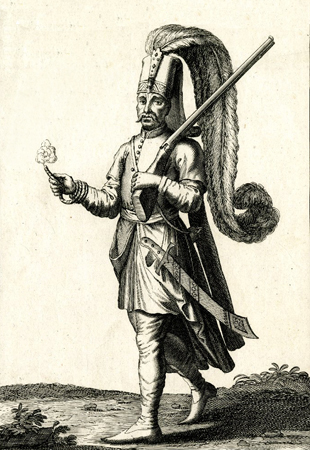(This post is a continuation of Janissaries in Algiers – Part 1. If you haven’t done so already, it’s best to read that post before continuing on here.)
The 2,000 janissaries that Suleiman the Magnificent, the Ottoman Sultan, sent to Algiers around 1530 to shore up Hayreddin Barbarossa’s rule of that city were part of an elite military organization.
By today’s standards, they were an odd bunch, for they were, technically, slaves.
The origins of the janissaries dated back to the fourteenth century, when the Ottoman Sultan of the time, Murad I, gathered together young male slaves taken as captives in wars against infidel enemies to create an elite military unit: the Kapıkulu Ocağı (“servants (slaves) of the hearth” in Turkish, i.e., servants of the Sultan’s hearth). The Ottoman Sultanate—like autocratic rulerships everywhere—was beset by a swirling complex of political intrigue, with different local factions vying for power. It was a challenge for a Sultan to know who to trust and who not to trust. Since slaves were not part of local political alliances and had no remaining family ties, they could be trained to be loyal to the Sultan and serve as a force he could trust and rely on.
These slaves were available to the Sultan because of a tradition known as the pencyek: sultans were entitled to one fifth of all booty taken in a just war against the infidels—including captives. Murad I and his successors exercised their pencyek right and gathered up young, healthy male captives, trained them, and formed them into a military unit that served the Sultans alone.
This system proved successful enough that, after a few decades, it was expanded. The pencyek could not supply enough young bodies, though, and it was augmented with a new method of acquiring slaves: the devşirme (a Turkish term meaning “collecting” or “gathering,” though it is also translated sometimes as “blood tax” or “child levy”). Starting around the end of the fourteenth and beginning of the fifteenth centuries, the devşirme began to replace the pencyek as the prime source of eligible young men.
As with the pencyek captives, those gathered by the devşirme came from non-Muslim territory. They were not captives taken in war, though. Every five years or so, Turkish officials accompanied by special military units would travel through the Balkans (then a territory of the Ottoman Empire) and, later, Anatolia (what is now Geographical Turkey) choosing healthy young boys and removing them from Christian families. Christians could live in Muslim lands and retain their religion because of their protected dhimmī status as “people of the book”; they paid a head tax known as the jizya and were treated as second-class citizens in many ways, but they were otherwise free to live their lives and practice their religion.
The Turkish devşirme expeditions took boys between the ages of six and ten, averaging about one out of every forty households. It was, of course, traumatic for the families involved—at least for most of them. For some, however, especially the very poor, having their young son taken as a janissary-to-be could represent a potential positive development, for as a janissary their son might actually have a chance at a better life.
The boys acquired during the devşirme expeditions were not immediately given military training. Instead, they were distributed among Turkish families, taught to speak Turkish, and converted to Islam. Mostly, they went to farms and spent the next six or seven years of their lives toiling in the fields. This provided free labor for the Turkish farmers, but all that physical work also produced strapping young men. At the end of their time on the farm, the devşirme boys had been thoroughly acculturated: they were Muslim instead of Christian, spoke Turkish instead of their original language, and were fit and ready for military training.
The training wasn’t just military, though. The acemiler, as they were known (the “recruits”), were taught the use of the sword, the javelin, the bow, and the matchlock musket, but they were also trained as engineers, clerics, and administrators. Depending on his aptitudes, a particular acemi might take any of a number of career paths, for janissaries became not only soldiers but also bureaucrats, provincial governors and viziers.
The initial training for these acemiler was extremely strict. They lived in communal barracks, were expected to remain celibate, and were put through a grueling instruction regimen for anything up to five or six years. At the end of it, they formed a highly disciplined, highly trained military organization, the members of which lived and worked and fought (and died) together as brothers.
They became Yeni Çeri (new soldiers)—the English term “janissaries” being a corruption of the original Turkish. This designation derived from the original founding of the janissaries as “new soldiers” rather than referring to the newly commissioned acemiler themselves.
The Yeni Çeri had no life outside their military unit and were expected to remain unmarried. The children of those who did end up marrying later on life were not permitted to become janissaries. Each succeeding generation was drawn from a new crop of devşirme boys.
One of the odd ironies about the janissaries is that they remained slaves. They were slaves of the Sultan, though. As such, they actually had higher status than many freemen. They were an elite force, and they knew it. They filled positions in every part of the Ottoman government, both civilian and military. In time, they even became king makers.
Such were the 2,000 janissaries that Suleiman the Magnificent, the Ottoman Sultan, sent to Algiers around 1530 to shore up Hayreddin Barbarossa’s rule of that city.
Their posting there changed them in ways nobody at the time could have anticipated, however.
__________
For more on the janissaries of Algiers, see the next post in this series here in this blog.
 The Travels of Reverend Ólafur Egilsson
The Travels of Reverend Ólafur Egilsson
The story of the Barbary corsair raid on Iceland in 1627
Amazon listing